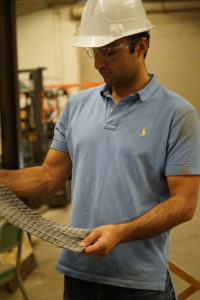Video and photo by Ron Bend
Nothing lasts for forever - including hundreds of navigational structures in U.S. waterways. These aging, critical pieces of infrastructure draw the research passion of Hussam Mahmoud, assistant professor of civil and environmental engineering at Colorado State University.
Mahmoud is leading a team that’s devising innovative repairs for steel structures in canals and rivers – some dating back to the 1920s – that are showing their age due to corrosion, fatiguing and cracking. The team is heads-down on an experiment in CSU’s Structural Laboratory, located at the Foothills Campus.
In the lab, Mahmoud and team are testing the structural integrity of a steel plate submerged in a churning water bath. The plate represents a hydraulic structure called a miter gate, which opens and closes in a river lock many times a day. A long, irregular crack is visible on the experimental plate’s surface.
The civil engineers are analyzing how cracks behave in various conditions, and how and when they lead to structural failure. In doing so, they are testing cost-effective retrofits, with the goal of slowing or stopping the inexorable effects of aging.
“The presence of a crack is not a big deal, until that crack propagates, and then it becomes a big deal – to the point where the structure could collapse,” Mahmoud said.
Army Corps of Engineers project
They are nearing completion of the first phase of a project, supported by the U.S. Army Corps of Engineers, to provide new ways to repair such structures in heavily trafficked waterways, including the Mississippi River. The researchers are testing the efficacy of carbon fiber reinforced polymer sheets, adhered to existing cracks in steel. Some of their results have already been implemented in the field by the Army Corps, according to Mahmoud.

For an experiment running in early November, the researchers are using a 10-foot vertical actuator to bear about 120,000 pounds of force on a cracked plate, while water flows around it – simulating conditions in rivers and waterways. According to postdoctoral fellow Mehrdad Memari, they’ll subject the plate to about 500,000 force cycles before the crack spreads to the point of failure.
Memari and master’s student Bashir Ahmadi take shifts in the lab, keeping vigil over the plate day and night as the water and cyclic stress is constantly applied. The entire experiment should take a little over a week.
Community resilience
Another researcher with Mahmoud’s group, graduate student Stephanie Pilkington, is observing the experiment to gain insight into how navigation structure failures affect whole communities across the U.S.
Pilkington is studying resilience – a systems engineering approach to defining how a community “bounces back” from natural or manmade disasters like floods or fires. In this case, the potential complete shutdown of an economically important waterway could have devastating effects on the people near it.
In partnership with the CSU NIST Center for Risk-Based Community Resilience, Pilkington is building a resilience model that could be applied to many communities, and that takes into account the interconnected threads of civil structures, economics and sociological impacts. The carbon fiber retrofits Mahmoud’s group is testing could play a key role in bolstering a community’s resilience.
“If a retrofit can withstand a disaster, you can still have that transportation sector, which ties into your economic survival,” she said.